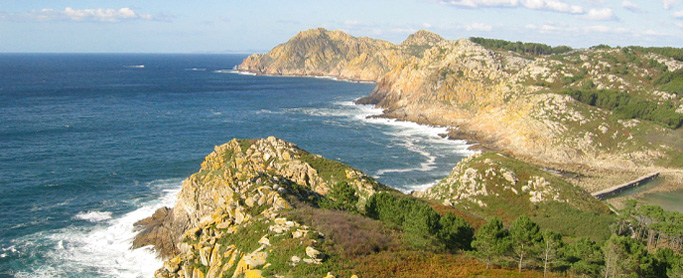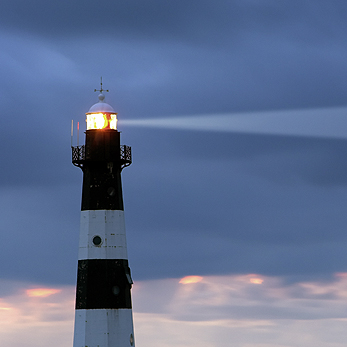Region IV – Bay of Biscay and Iberian Coast

Region IV is characterised by well-mixed waters and upwelling of nutrients and cold water along the continental slope. The area is strongly affected by people. The Iberian coast is densely populated, with more than 500 inhabitants per km2 in some areas and there are very active shipping routes. Most of the activities affecting the marine environment are concentrated along the narrow continental shelf, and coastal defences, cable-laying and tourism have all increased since 1998.
The seas are productive and there are large populations of pelagic fish. During spring, blooms of algae on the Iberian coast attract huge shoals of sardines and other fish. The coast is diverse, with many different habitats, from muddy shores to rocky cliffs. The seabed has some outstanding features, with seamounts and deep underwater canyons where giant squid and large sponges can be found. Because of its latitude, Region IV has both northerly species at the southern edge of their range and southerly or Mediterranean species at the northern edge of their range.
The QSR 2000 concluded that the quality status of Region IV was generally good, but a lack of information made it difficult to assess human impacts in many areas. Issues of high importance were: declining fish stocks (sardine, hake, anglerfish, bluefin tuna, swordfish); pressures from coastal development; and effects of climate change. Climate change has remained an ongoing concern.
| Eutrophication problem area extent | 0.6% |
| Monitored sites with unacceptable status | |
| – Mercury | 41% |
| – PAHs | 19% |
| Species under threat | 25 |
| Habitats under threat | 9 |
| MPA coverage | 0.5% |
Successes
Much better information than before. Although some gaps remain, there is much better knowledge about the state of the environment in Region IV than ten years ago.
Improvements in fishing practice. A number of improvements in fishing practice have been implemented to help protect the marine environment. For example, local prohibition of rock-hopper trawling has had a positive effect on the seabed and a driftnet ban has reduced the by-catch of marine mammals.
An important new protected area. The establishment of the El Cachucho MPA in the Cantabrian Sea is a major achievement. This MPA protects the wildlife associated with a seamount and a system of channels and canyons, and has strong measures to manage fisheries.
Ongoing concerns
Fish stocks in danger. The anchovy population in the Bay of Biscay has declined dramatically due to a lack of new young fish, and the fishery was closed between 2005 and 2009. The southern stock of hake is at low levels and subjected to unreported fishing. Most aspects of the demersal fish community on the French continental shelf are in a poorer state than in the mid- to late 1980s. There has been some improvement in the status of swordfish.
Eutrophication in the Bay of Biscay. There are eutrophication problems in small coastal bays and estuaries where waters are less active, particularly in the northern Bay of Biscay and in some estuaries on the Spanish and Portuguese coasts.
Shipping incidents. Ship traffic has been increasing in Region IV over the past 20 years. Vessels often hit rough seas as they enter the exposed waters of the Atlantic en route from the North Sea and Baltic regions, and older ships are particularly vulnerable to accidents that create spillage. The Prestige oil spill in 2002 killed thousands of seabirds, and damaged some of the last remaining colonies of the Iberian population of the guillemot. The long-term effects of this spill are still not known.
Hazardous chemicals. Mercury remains a particular problem in Region IV, with over 40% of sites having unacceptable levels in sediments, perhaps as a legacy of past mining activities. In general, there is little information from Portugal on this type of pollution, but on other coasts, pollution from hazardous substances is found in coastal locations close to urban and industrial areas.
New industry. There are plans to store CO2 under the Cantabrian continental shelf, and offshore wind, wave and tidal energy developments all seem likely in Region IV. As for the other OSPAR Regions, the long-term impacts and combined ecosystem effects of these activities are not well understood.
Lack of monitoring in deep sea areas (>200 m). Research has provided much greater knowledge of the habitats and ecosystems of this Region than was available ten years ago. Although the locations of canyons, seamounts and other important habitats are now known, there is no adequate monitoring of these sites. OSPAR must find ways and means to monitor marine life in these areas, so that it can assess and begin to understand human impacts.
What should be done?
- Develop coordinated spatial planning
The limited extent of the continental shelf in Region IV, especially around the Iberian peninsula, and the demand for space for human activities including marine renewable energy developments, mean improved marine spatial management is particularly urgent. - Expand the MPA network
In Region IV there is a need to build upon the MPAs that have been established so far, to ensure that ecologically important areas are protected and form part of a network. - Promote sustainable fishing
OSPAR must promote the development of fisheries management plans that address depleted stocks, and encourage the collection of data to support the management of mixed fisheries.

